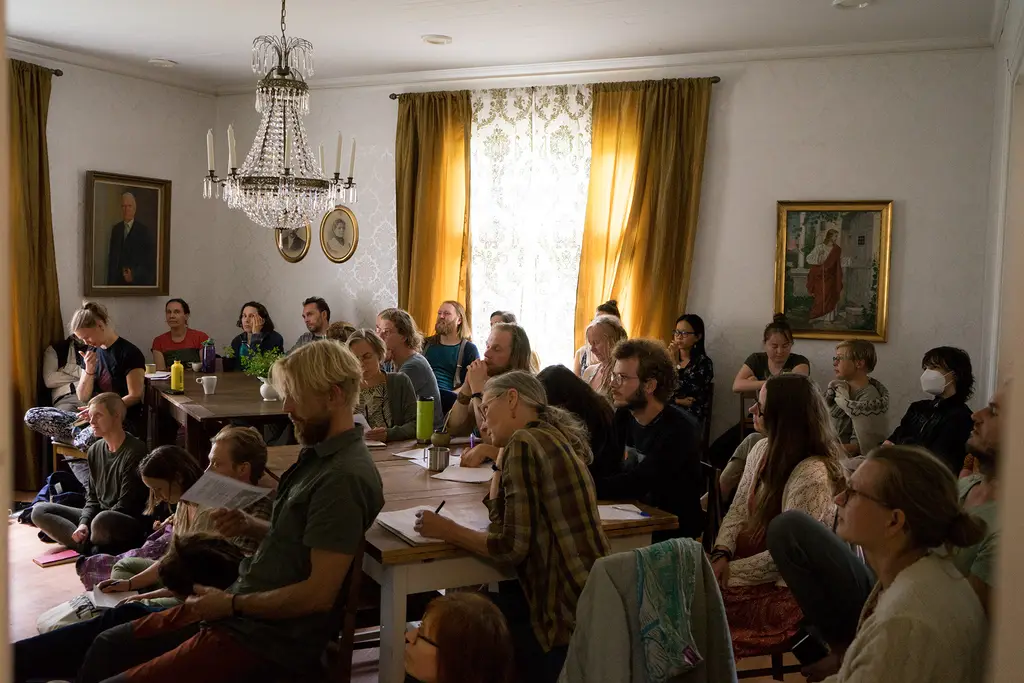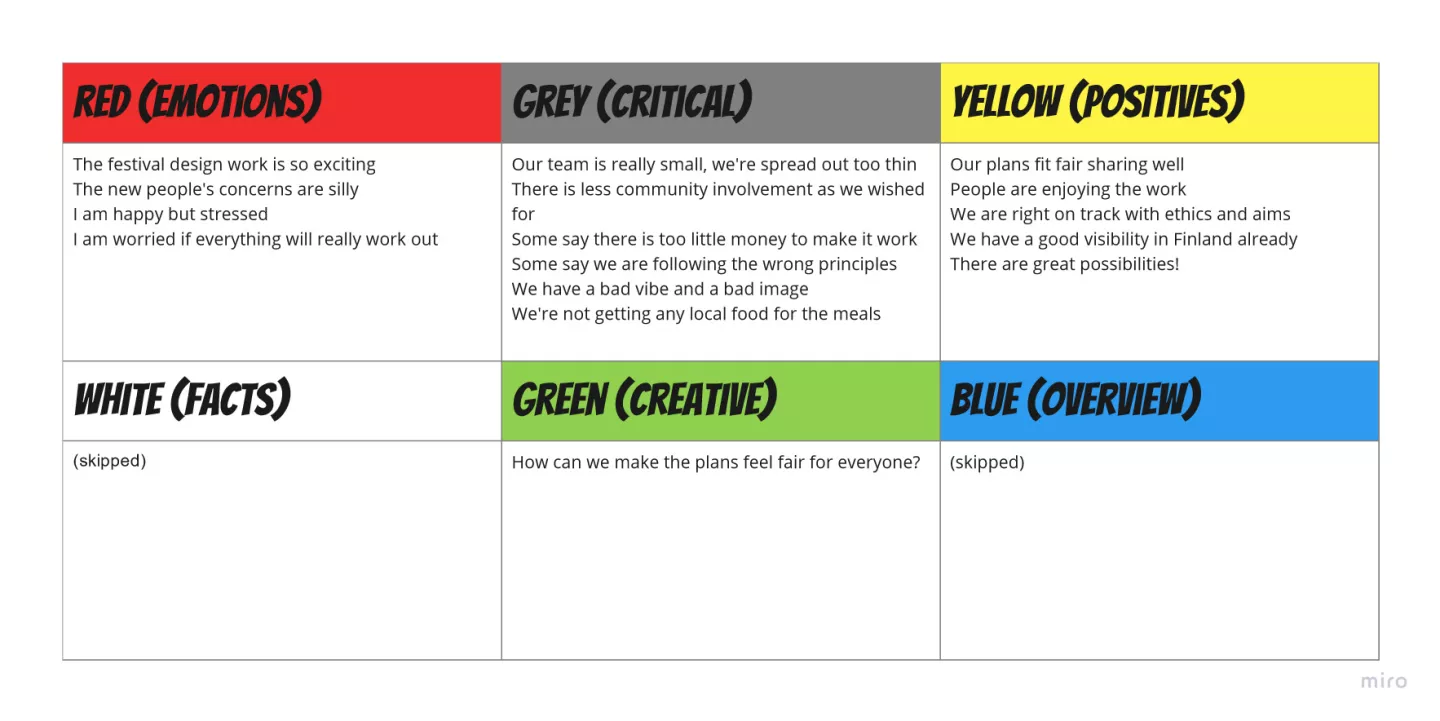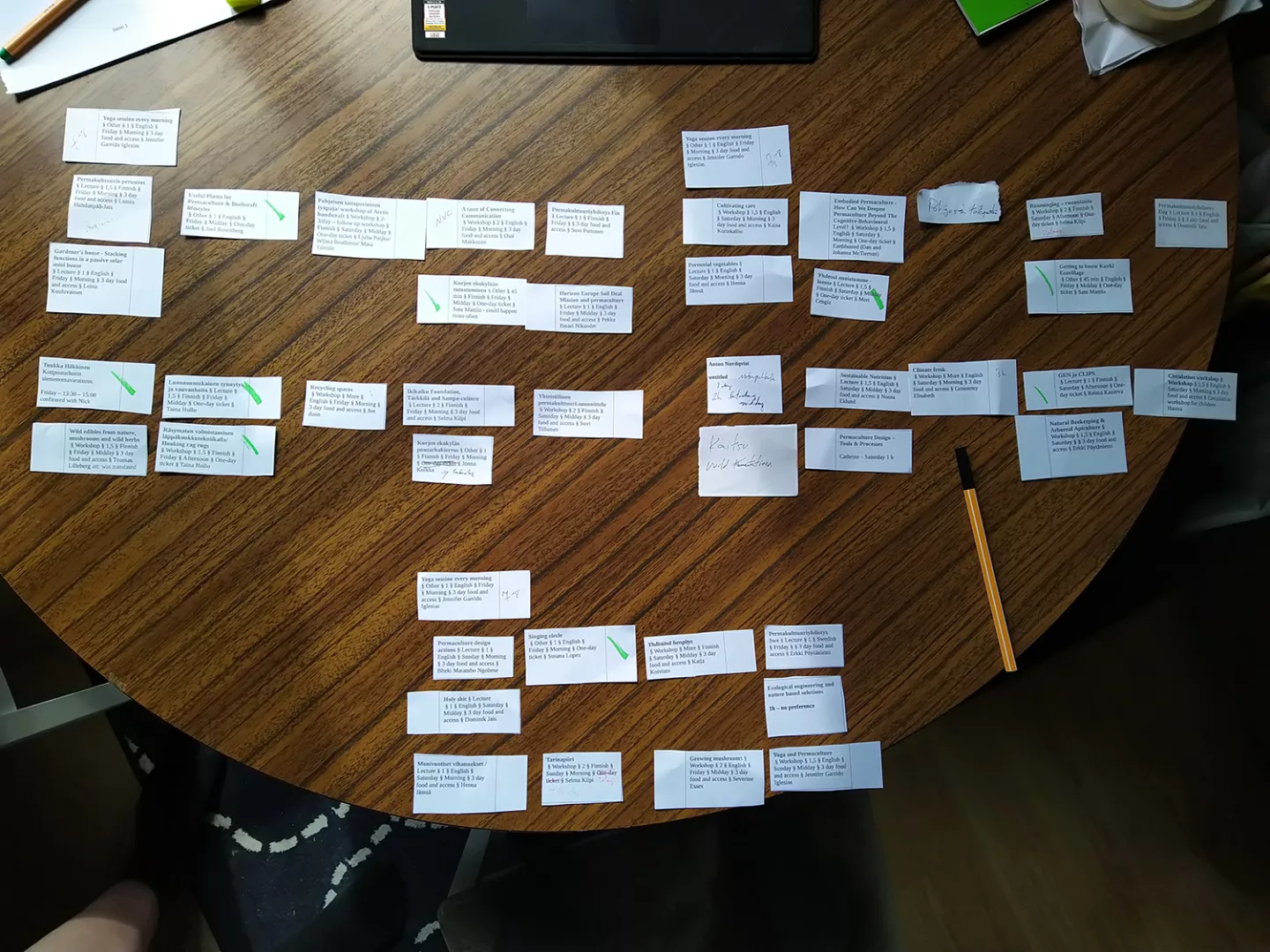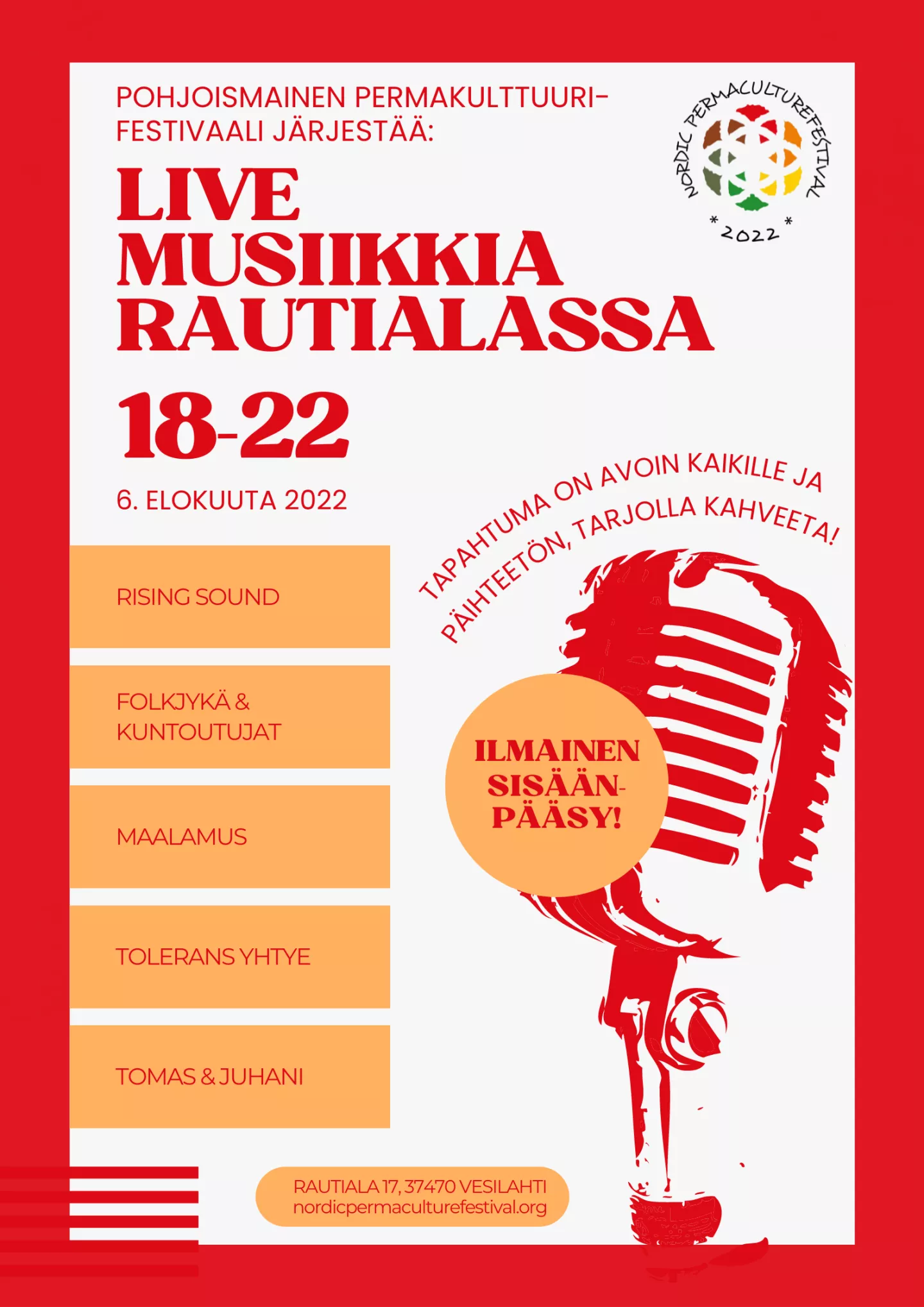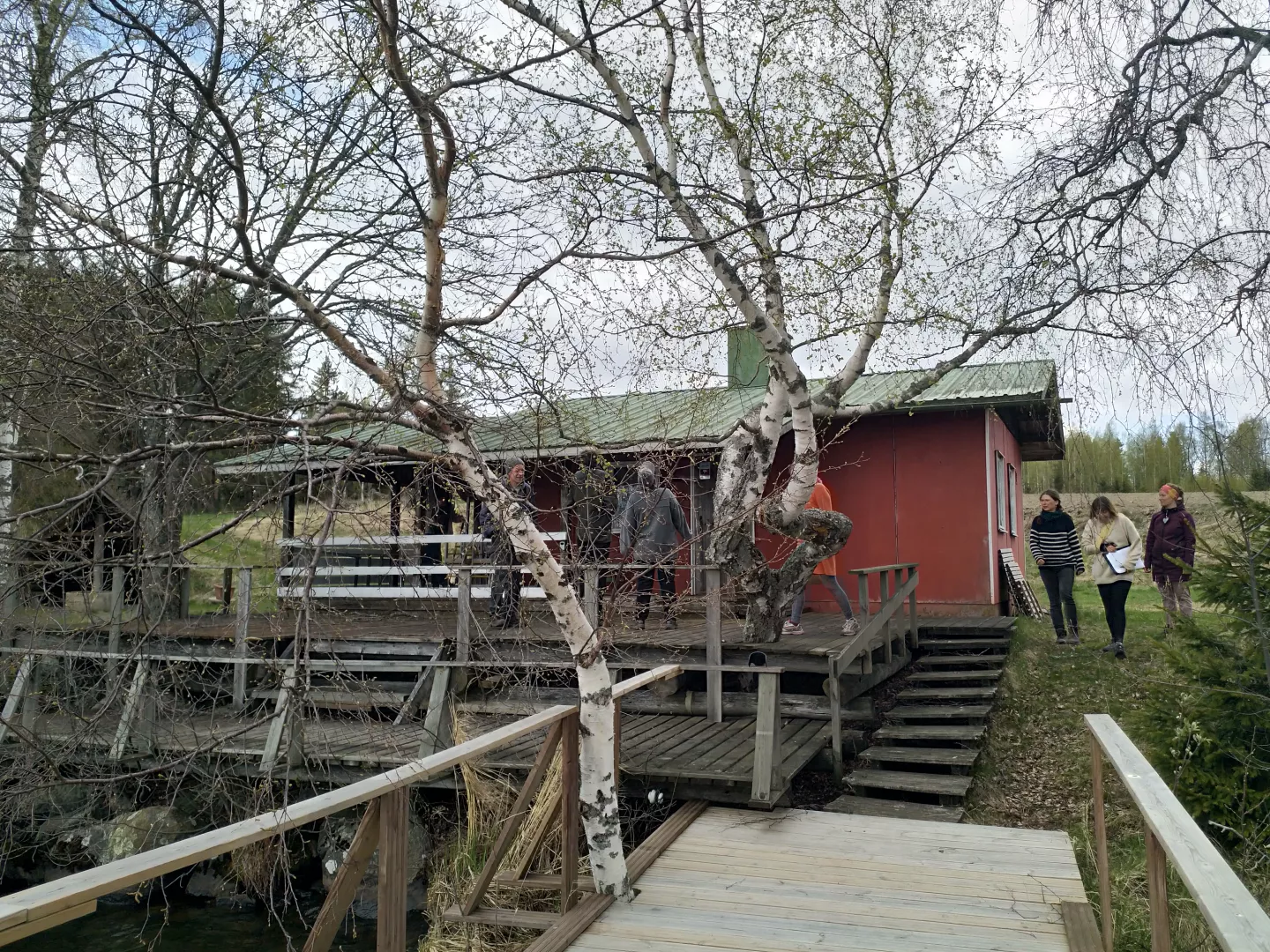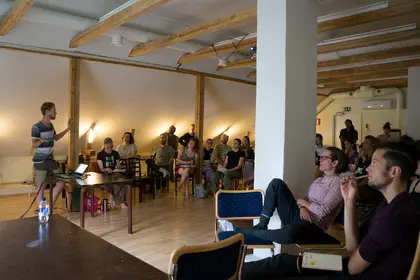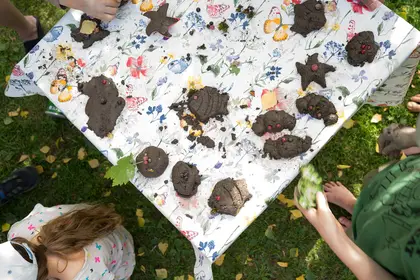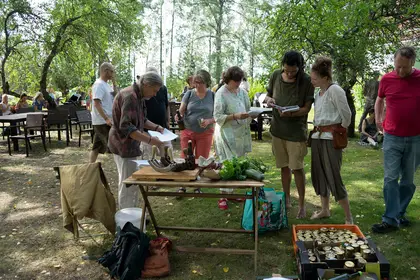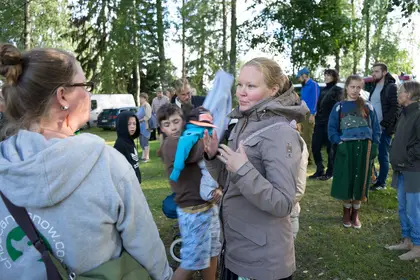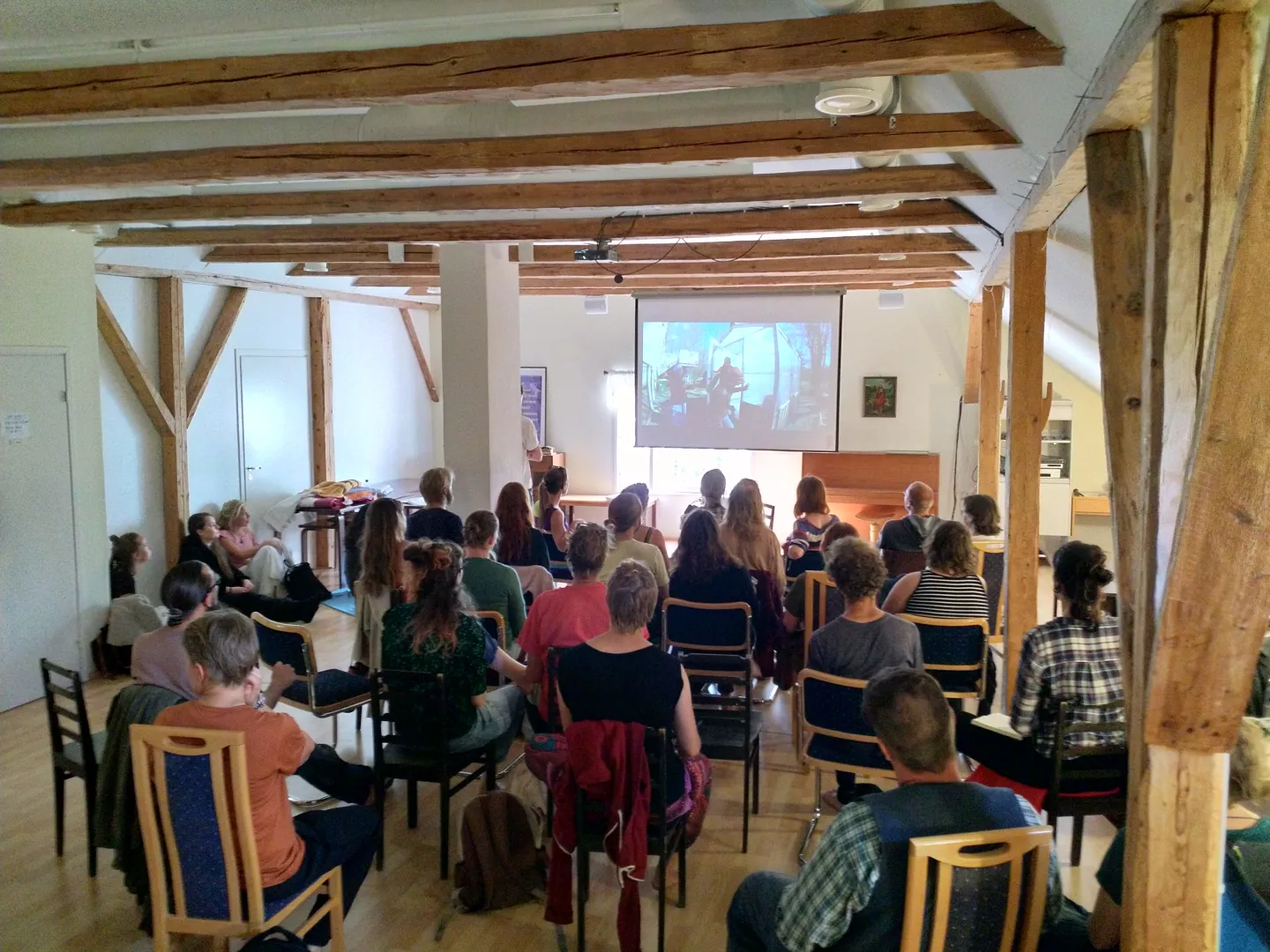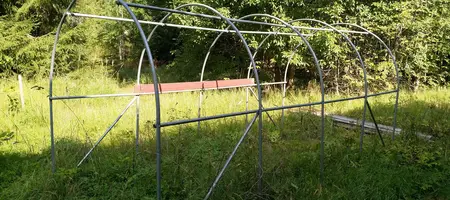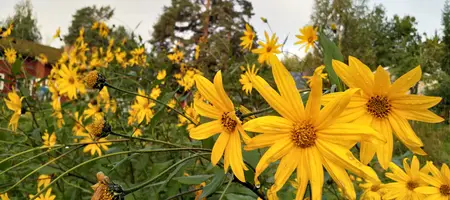Summary
Design for the 2022 NPF (Nordic Permaculture Festival) in Vesilahti, Finland. Part Three, the Action Phase. We have the team, the processes and the technical side set-up, so it is time to get rocking. I describe some problems we encountered in the team and how they were solved. You will find information about our decisions as well as our plans in Integration & Action. In Momentum I describe the “designing in the flow” during the festival. The design ends with some reflection.
Read Part One of the design here.
Read Part Two of the design here.
Action – meeting plan
The meeting schedule was set to every other Wednesday 17.30-19.00 and as a general meeting structure
- general topics
- circle updates per circle
- informational/other topics
was agreed.
The subcircles chose their own meeting times, most often every other week than the core team calls, or ad-hoc.
Principles for action phase
Obtain a yield
The festival’s main goal is to bring people together to learn from each other, get inspired and take action. That is the main yield we need to keep in mind at all times. The project must also be finished in time and budget, and as a good experience to everyone involved in creating it.
Creatively use and respond to change
My motto in this design is: whatever happens, we’ll deal with it.
Background info – trouble in the team
By the end of March ‘22 there were two problems to solve.
- There were concerns that we were not paying teachers or artists and/or that we were compensating them only with a discount to the ticket, thus making the artist/teacher in a way pay for working at the festival.
- Piritta had to quit the team. Dora had also quit, but that was not an issue as the Program team was going strong.
The first problem was brought to discussion in Slack. It was rather fast made nasty and personal by a non-team-member. At this time Dominik put on his FPA (Finnish Permaculture Association) chair hat and took the matter to the board, who found nothing wrong with our approach. At the same time I contacted Reija again to ask if they had the same kinds of problems in 2016 – they did, but Reija also reminded us that we are mere shepherds of this festival and can’t go around changing the grounding principles of the festival (“To keep the festival affordable for as many people as possible and To be based on voluntary engagement.”)
Reflection & Patterns
I simply could not understand how someone can have a problem with something that was not our to discuss – it would be something for the whole Nordic community. I am very glad Dominik helped here and the project got back on track fast.
What really blew my mind though was that our concept of “same money for same time”, which meant one hour of teacher work was worth the same (in money and in spirit) as one hour of volunteer work or one hour of artist work was somehow “stupid” as this one person put it.
I see behind that kind of thinking a capitalist pattern of “some people are worth more than others”, which is so wide-spread in our society that it is not always seen as a belief system or a pattern, but a one and only truth.
It really got me thinking about what some people really see as fair or unfair, and how “alternative” some of the team’s visions and ideas really were. For me, I don’t need to pay some PhDs or famous people more than anyone else doing a task worth doing.
6 Thinking Hats Review
Nonetheless, because of these two problems I did a simple six hat review on my own (read about De Bono’s 6 Thinking Hats here (link to debonogroup.com).
Ideas & Integration
The episode, Sampsa’s original concern, a little survey I did on my own social media and the 6 hat review that followed did get me thinking again. I worked on the budget, and a new teacher & volunteer pricing model as well as the day ticket concept emerged (thanks for Dan for suggesting this). This way a teacher could choose only to come for a day, teach, eat and enjoy the program – or they could choose to pay for accommodation and stay for the whole festival. This was agreed.
For the second problem it was clear we’d need someone for the Comms lead role. Before I got nervous, Noora signed up as a volunteer in April, and some mails and a call later we had a new Comms leader.
Appreciation
Just trust the process and the right people will come and the solutions will fall into place!
Integration & Action – the real deal
Communication
You can see the vastness of the comms’ teams work as well in their meeting notes. Their part of the task list from Trello is shared later in this design in the next “Action” bit.
See also
- Website: https://2022.nordicpermaculturefestival.org/ (was: nordicpermaculturefestival.org, but has now been archived)
- https://www.facebook.com/TheNordicPermacultureFestival
- https://www.instagram.com/nordicpermaculturefestival/
Program
This text is written by Dominik Jais, who lead the Program team and whom I asked to write about their work:
“The program of the festival is based on a pull principle. Instead of doing a lot of work and asking individuals for contribution to the program, we just put the word out that we are looking for lectures, sessions and other program contributions. By doing that, we reach Zone 5 instead of just Zone 1 and 2. Zone 5 are the people that no one of the team has met before, while 1 and 2 are friends, family and acquaintances. We basically, as a team, don’t know that those people who will contribute exist. For sure there will be people from Zone 1 and 2 contributing to the program, too, but I have spared the team 50 hours of work and used the principle of “value and use diversity” and also of “value the marginal” by choosing to go with pull. Time is scarce, and so are people who freely offer their time to work on volunteer projects, so it’s best to use their time wisely.
One of the benefits using that principle is that you get new people for topics that are usually been given to “top dogs”. If you look at for example the 2021 Permaculture convergence and compare it with other programs and festivals you will see that the same people are always asked for contribution. With a pull principle those people are usually reached last, because they rely on being asked.
We got a lot of lectures in time – the deadline for submission using the web form on the website was 31st of May. And of course it is a gaussian curve, where the most contributions come right before the deadline. The deadline was set in order to give the team enough time to compile the schedule and, in case of problems, get them solved without any pressure.
After the deadline Maggie and I played a placement game. We put every session on a separate small piece of paper, like credit card size, and then created 3 columns for Friday, Saturday and Sunday. Each of the cards had noted the lecture, the teacher, personal preference, and duration of the lecture. When a teacher submitted a lecture we asked for their preferred day and daytime, like Friday morning, Saturday afternoon, etc – that is meant with personal preference.
We then counted the cards – yeah, no, not black jack – to see how many lectures per day were available. From the sum we determined how many parallel slots we needed. We made sure that similar topics like food forest and perennials weren’t during the same time. We also discussed the amount of people who might attend a certain lecture. An edible food forest lecture will of course drew more attention than one about bees. Bigger demand = bigger room. Maggie and I played our card came (which actually was remote – Maggie had the same set of cards) for maybe 1,5 hours and then crafted the actual schedule in a spread sheet. A mixture of analog and digital tools get you further than one alone. “
The program was “alive” up to the festival. A week before the festival, our NLP teacher had to cancel, and that left a gap into the program. That was no problem though, as we had three to four parallel sessions going on all the time, anyway.
Here is the final program schedule as a download.
| Attachment | Size |
|---|---|
| Final program of NPF22 | 59.38 KB |
Party
The party was 80% designed and planned by Rosabella. As she joined the team, she mentioned due to a disability she couldn’t keep up with the written English communications the team had agreed on. So we searched for solutions together. One suggestion was to work on an area on her own and connect with the team mostly only in the bi-weekly calls. This suited her, as party planning is something she is very experienced in. We agreed on the parameters like budget, duration, time, what kind of party it should be (in DIY spirit, family friendly and alcohol-free, with music and so on) and she got to it.
For the party we needed of course music, a lovely setting and good food. The party would be open for all, not only festival goers. In addition to the bands on the poster, there would also be a welcome speech by Laura and Elisabeth.
Bands
- Folkjykä & Kuntoutujat
- Maalamus (music and painting combined)
- Tolerans yhtye
- Tomas & Juhani
- and DJ Rising sound between the bands.
Party food
There would be vegan, gluten free flatbread rolls and cake bits as well as coffee. These would be served at 6 pm in the Main house, before the music started. Tuija from the ecovillage would manage this part.
Money
Budget
For the budget, a spreadsheet was created, taking inspiration from the budget in 2016. I made the first draft which was then discussed in the team and as things got more concrete, I made new versions of it.
The last version of the budget, pre-festival (26.07.22), can be found as a download below.
| Attachment | Size |
|---|---|
| Final budget of NPF22 pre-festival | 61.02 KB |
Sponsors and grants
We co-created a list of possible sponsors and grant givers, as well as a three-tier sponsorship model. The possible sponsors were contacted and grants applied. We got two grants (one through Kurki Ecovillage association) and were able to win over two sponsors.
Sharing the surplus
It was decided early on, that as we received a starting capital from Sweden, amounting to 940 euros, we’d budget 1000 euros as a fair share, passing the gift we got on to the organizers of NPF23.
Tickets
The final ticket prices were:
- 3 day ticket with camping: 125 €
- 3 day ticket with floor accommodation: 150 €
- 3 day ticket with a bed spot in a shared room: 180 €
All prices include program, food, accommodation and sauna.
The ticket sales went live on April 1st 2022.
Pretty soon afterwards we decided to scrap the floor accommodation and a day ticket for 50 € per day (without accommodation) was introduced. In the last week before the festival, because of high demand, even a day ticket without food for the same 50 € was added and a few of them were even sold.
Places
As for where the lectures etc. would take place, the following was planned – and sometimes even executed as such. Even if not documented sufficiently, we did keep flow of people and edges in mind while designing this part. Read more about the changes in Momentum. This table dips into that phase a little (columns 3-4, to save space included in this table).
| Lecture spaces | Planned use | Final use | Planned/final zone |
| Main house, hall | Serving & eating food | Serving & eating food, also used to extend the lecture room “downstairs room” | 1/1 |
| Main house, small side room | Kid’s program in bad weather | Kid’s program in bad weather | 1/2 |
| Main house, bigger side room | Smaller workshops | Relaxing space | 1/3 |
| Main house, downstairs room | Eating food | Lecture room | 2/1 |
| Main house, upstairs space | Main lecture room | Main lecture room, yoga | 1/1 |
| Navetta, downstairs | Lecture room | Not used (not allowed) | 1/5 |
| Navetta, upstairs | Party & yoga | Not used (not allowed) | 2/5 |
| Kurjen, main hall “Mankeli” | Lecture room | Lecture room | 1/1 |
| Sleeping spaces | |||
| Granary, five rooms | Sleeping | Sleeping | 2/2 |
| House of hope, seven rooms | Sleeping | Sleeping | 2/2 |
| Tiny house, two rooms | Headquarters and storage. One sleeping, one info stand and relaxing | Headquarters and storage. One sleeping, one not used (reserved for relaxing) | 2/2 |
| Kurjen balkony | Sleeping for volunteers | Sleeping for volunteers | 2/2 |
| Other spaces | |||
| “My room”, Kurjen | Relaxing space | Relaxing space (wasn’t used) | 3/4 |
| Beach sauna & outdoors | Bathing, swimming & connection, camping | Bathing, swimming & connection, lectures | 3/3 |
| Showers, dryland sauna | Showering, family sauna | Showering | 3/3 |
| Outdoors | Eating, lectures, camping, connection, dishwashing, info tent at entrance | Eating, lectures, camping, connection, dishwashing, party, info tent at entrance | 1-5/1-5 |
Table 1: Places and their planned and final use, zones
Zones key:
Zone 1: lecture rooms; spaces and areas in constant use
Zone 2: sleeping rooms, café, info tent and headquarters; spaces in intermittent, frequent use
Zone 3: sauna, showers, party space; spaces in time-to-time use
Zone 4: areas that might get visited by some participants
Zone 5: navetta and other off-limits spaces and areas
Toilets
The toilets were a theme from the beginning. Early on it was stated that building dry toilets would be possible, but soon it became clear the problem would be the poo and pee’s final destination. We had to accept that there would be no dry toilets other than the one at the ecovillage and one at the beach sauna. Had we known this while deciding on the location, it might have made a difference. But now here we were.
We’d have seven water toilets, a staff water toilet and three composting toilets, so the amount of toilets was ok.
Tweaks: around three days before the festival, Rautiala suddenly suggested we rent three big pissoirs from a nearby restaurant to enable at least gentlemen to pee without flushing. We of course took the offer.
Sauna
There is a big sauna on the beach. There is a dryland sauna near the navetta. It was planned that there will be sauna every evening, first separate ladies/gents and then joint at the beach sauna. The dryland sauna was to be as a showering space only.
Food
One of the main reasons we chose Kurjen and Rautiala was that the catering could be taken care of for a reasonable price and not fall onto the volunteers. Tiina, the chef at Rautiala made us an offer early on (Sept ‘21) for lunches and dinners with dessert, and Kurjen volunteered to make the breakfasts. For extra snacks we’d have the DIY café and the Café by Kurjen. The food would be lactose-free vegetarian, with gluten free and vegan options. The food would be simple, as local as possible, and we scrapped the desserts and coffee at lunch that were agreed in the original offer, as the inflation since had been rampant.
Food plans
| Day | Thursday | Friday | Saturday | Sunday |
| Breakfast | n/a | Porridge & condiments | Porridge & condiments | Porridge & condiments |
| Lunch | At Kurjen for volunteers | Soup | Summer soup, oat bread | Pasta with bean & tomato sauce |
| Dinner | Potluck/BYO | Roasted vegetables & local potatoes, salad | Rice and vegetables, salad | n/a |
Table 2: Food plans
Now writing up the design, I cannot remember or find notes on what we had for lunch on Friday to save my life!
The dishwashing would be done outside using the three-bucket-system: pre-rinse, wash, rinse in two lines by everyone themselves.
Volunteer management
For a festival this size we’d need onsite volunteers that would take care of tasks like tending to the dishwashing station, general cleanliness, heating the sauna and so on. The volunteer management was a task of two of the ESC volunteers at Kurjen, Elisabeth and Laura who had joined the team in March ‘22, and myself.
Based on the calculations we inherited from the team of 2016, I created some new tables to find out how many people we would need for how many hours.
Volunteer search
April 2022
To search for the volunteers, we used our pull principle and opened a form on the website. Of course we also posted about it in the festivals’ social media. It was no trouble at all to fill the spots.
Team building
May-July 2022
We had two calls before the festival to get to know everyone, to get people excited about the festival and to make sure everyone was on the same page regarding what the festival is and what they would be doing there. The first meeting was in May and the second one in July. There were also general emails with infos to the volunteers throughout the summer, and of course individual questions were answered personally, usually per email.
| Attachment | Size |
|---|---|
| NPF22 final volunteer plan | 31.69 KB |
Action – task list
To track our tasks, we used the Trello application, which we used as a kanban style task list.
Momentum
Maintenance & communication plan for the weekend
For the communication onsite a Whatsapp-group was created for the core team. We resisted it so far, but onsite it made sense. Whatsapp was chosen because everyone on the team had it.
There was a separate Whatsapp-group for the volunteers. A few volunteers didn’t use the app, but didn’t resist others using it, so it was created. The others would be called if needed. It helped us a lot keeping in touch during the festival and finding people when help was needed. There were also meetings each morning to align to the day.
The actual maintenance plan for the weekend was to execute the action plans (program, food, volunteer plan etc. as linked earlier in the design) and if something went awry, deal with it together, creatively responding to change.
Of course, for the biggest risks (like accidents/illness fire, storm, violence etc.) and how to deal with them were described in a security plan, that we were required to do by law.
The rest of this chapter describes designing on the fly onsite aka dealing with it during the festival 3rd-7th August 2022.
Location
The first “bomb” landed when we arrived at Rautiala on Wednesday, one day before the festival. We were briskly told us that the Navetta could not be used at all, as it had been deemed unsafe by the authorities the previous weekend. Nice! That meant we were missing a lecture room, a space for the DIY café as well as space for the party.
Me, Tiina and Satu tried to stay calm and carry on. The lecture room was moved to the main house, to the room next to the dining room. It was much smaller than the one in Navetta, but the only one available. The DIY Café was moved to the garage to share space with Café by Kurjen. And the party was moved outside. The maps needed to be updated asap, too.
Unrelated to this, we realized having the info room in the small house was a really bad idea, no-one would find their way there. We decided to keep the Info at the entrance tent for all the slots.
Water issues
On Friday Tiina came to us with the second “bomb” informing us that there will be a water shortage soon. I was like: what? She then told me that the site has their own well and people should start to limit their water consumption immediately so that the water wouldn’t run out. This was why she had thought of the pissoirs also.
I was dumbstruck. Why wasn’t this told before? I felt awful and deceived to be honest, but again here we were, and the only solution was to solve the problem.
We wrote signs to all the toilet doors and informed everyone to please use the pissoirs and bushes. We managed to end the festival with water still available.
Sauna
For the sauna, Rautiala had made a double booking for Friday, which meant on the best bathing day we could only go to the sauna at 20 o’clock. As annoying as that was, the ladies’ sauna was packed that evening, I tell you!
In the last minute we had an idea of a family sauna in the dry land sauna, that families could heat for themselves. It was not of interest to the participants.
Food
The food was served as planned. The Thursday potluck was amazing, people brought the loveliest things. The dishwashing station worked nicely.
Program
The program played out as planned.
Money
The money aspect worked as planned onsite. There were few individuals that came to “the door” looking for tickets – they were invited to listen in on a lecture or hang around a bit, but no money was handled.
Party
Like the DIY Café, the party also suffered from the Wednesday bomb of Navetta not being available. Luckily there were two party tents available to get the instruments and sound system under a roof. The party was moved outdoors, and it worked out.
Pause
After the festival, in the early hours of Monday the 8th of August, I brought Dominik to the airport, as he had to leave for a family funeral. This unexpected, forced pause by myself at home was all in all, fine. Right now, writing this design up in February ‘23, I can’t remember much of that week. I think I just slept and tended to the garden.
Appreciation
For appreciation, reflection and a bit of a pause we had a get-together in Pälkäne on 17th of September. I had booked a beach sauna and we had lovely pizzas and salad from a local restaurant, as well as a good selection of non-alcoholic drinks. Not everyone made it, and I was a bit ill, but it was a lovely evening to just hang out, appreciate what we had done and talk a bit about the festival and our journey.
Reflection
We stayed well in budget, and managed to create a small surplus.
As for the final reflection, let’s start with feedback I gathered form a) the core team and b) the participants, including volunteers and teachers. We had two separate feedback forms on the website – the other was shared with the core team, the other with all participants. For the questions I used a tool I learned through Dominik, who learned it from Mihail Kossev during their TPT: What was best, what was worst and what would you change. Plus a few other things!
Reflecting on the festival
Feedback
Feedback from the participants, 19 people answering.
Summary of feedback:
- What was best: The people! The atmosphere, the lectures, the sauna.
- What was worst: Food! Lack of toilets, lack of composting toilets. Fear if water running out, and fear of a storm. Too tight lecture rooms. Sauna double booking. Some topics in the lectures. Drama.
- What would you change: More toilets! Composting toilets. Better/more local food. More food. Other kinds of workshops. Bigger spaces. Longer festival. Better maps and info about location.
My reflection on the festival
Do you know the feeling, when something inconcrete is so close that you can see it’s shape and form? That’s what happened. When the festival started, I realized I need to let go. It was like a wave that had been forming on the ocean and I, or we, had had in reigns until now, that now needed to hit the shore and create the shape on the sand it was supposed to create. I almost physically noticed letting go of the reigns and surrendering to emergence, as the first people started arriving. From that point on I was a servant of the festival, in a way – just someone to make sure the wave can hit the sand freely, unhindered.
What I did throughout the festival was to walk in rounds. I started from our little cabin, to the DIY Café and dishwashing station, to the main house and kitchen, to the outside chill-out area, to the Info tent, to the party location, and back again. At all stations, someone would tell me something, ask for something or have a question. I would answer questions, delegate tasks, take the news or questions to the next station, and bring whatever someone was needing back the next round. The round walking was really relaxing in a way. It removed all need for running back and forth. Everything would get taken care of in the next round (if it wasn’t an emergency, of course). I really enjoyed these rounds. For a Pause, I puttered in my DIY Café and I also went to the sauna every evening and slept full nights in the little cabin. It worked. I didn’t feel overstressed, generally.
I personally feel everything went surprisingly well. I have discussed the big surprises in Momentum, and do feel we dodged a bullet in some ways with the water, and even the wind on Saturday could have become a storm with very bad luck. We had good luck, and I am thankful.
But if I were to do a best, worst, change about the festival, I would say
- What was best: The mostly relaxed feeling and very little “karens and brads” (people who love to complain), everyone working together to create a great experience. People taking responsibility, as anyone interested in permaculture should.
- What was worst: The surprises onsite, that shouldn’t have been surprises. Not being able to tell everyone “hey, we HAD an NVC workshop planned and we DID want composting toilets and more practical workshops, it just didn’t work out!” Feeling misunderstood at times.
- What would I change: As for the festival, I can’t really think of anything.
Reflecting on the design / process of creating the festival
Feedback from core team
Let’s hear from the team first. Feedback from the core team, 5 people answering. See their answers below.
| Attachment | Size |
|---|---|
| Core team feedback on NPF Design process | 37.07 KB |
My own best, worst, change for the process, including lessons learnt:
- What was best: The trust. Trust in the process, and trust in the team. Everyone taking responsibility and doing their absolute best. The immense learning that happened throughout the year. I didn’t know really if I could do it. I did, and I did it well. It was a real confidence boost. Learning to chill in a storm. It’s an amazing skill that I have now and doubt that I will ever lose. I love that I was able to really enjoy the process and the festival, too.
- What was worst: Not delegating enough. I could have, I am sure, but I at times didn’t know how. Feeling sad that I kept the team thinking about unimportant-to-them things just because they were big in my mind (like the t-shirt thing was a prestige and power question with the FPA board, who decided to start micromanaging us there. If I had said on my own, no shirts please, a shitshorm would have started. The mandate from the whole team was essential. But of course they didn’t know it at the time.)
- What would I change: I would ask stupid questions from the start (like “will there be enough water”). Improve my communication throughout! Delegate even more.
Reflection on the ethics
I feel we succeeded well in regards to the ethics. The festival, compared to some “normal” festivals was really simple. There were very little purchases of non-perishables made to make the event happen, and even less of that was bought new. The water usage was very limited due to the problems, so something bright about that? All other resource use like firewood for the sauna was very reasonable. For the food we did the best we could. There is certainly room for improvement there.
I think we nailed the people care. I believe not everyone was comfortable at all times (camping, bush peeing etc), but I want to believe that everyone learned and felt a connection of a kind during the event.
Fair share. I think we did ok. The festival was about sharing knowledge, after all. Whatever financial surplus we had, was divided in the team. The share for Norway (NPF23) was given, and the surplus on-site was also divided between people who wanted it (extra food, etc.).
Reflecting on the design through the principles
Just choosing a few here to reflect on the whole design, all three parts of it.
The yield is theoretically unlimited
In Part One I said “By not limiting who can come to the workshop there are limitless possibilities of what the event could be and bring.” This worked. We had very different people in the team with amazing wisdom and knowledge and ideas. The yield of the pull principle was indeed unlimited, as was the creativity and effectiveness of the team. And fun, too!
As for the festival, I do feel we really stacked yields upon yields. What did it bring?
- massive amounts of learning, knowledge and wisdom
- inspiration
- meeting old and new friends
- making connections with people, nature and culture
- new experiences
- financial benefits for Rautiala and Kurjen
- little financial benefits for team members
- coverage for Kurjen
- some press coverage about permaculture
- swapped seeds
- shared resources
- and just a lot of enjoyment and fun!
Apply self regulation and accept feedback
For the kick-off phase we really set ourselves limits time and content wise, which helped keep the young design manageable.
As for feedback, I do not regret not taking on the feedback that the festival should be built completely differently, based on money rather than sharing. They were wrong, and the community was right – regarding this festival. As for other feedback, I think we were able to discuss it in the team and find good solutions. Sociocracy and making sure everyone is heard really helped here.
And at the end, asking for feedback is certainly accepting it. I feel thankful that I can write this all up and share our path, problems and wins, as well as the feedback with the teams that will create the festival in the following years.
Creatively use and respond to change
I think this was the essence of the festival, looking back :D
Reflection on effectiveness
We managed to create the festival, and execute it from start to finish, so the design was effective. It achieved its stated goal. I am certain we could have done everything faster, had we had more experience and/or help though.
I'm skipping some personal reflections which were included in my Diploma work.
Thanks
One million billion thanks to Dominik, Maggie, Rosabella, Satu, Tiina, Laura, Elisabeth, Noora, Sampsa, Hanna, Tero, Sasha, Piritta, Reija, Alexis, Tuija, Susana, Alessandro, Ricardo, Alicia, Tiina, Rei, Maria, Lucia, Tiina, Laura, Tanja, Susanna, Santeri, Havu, Elmo, Carita and Ivan, as well as all the teachers and everyone at Kurki Ecovillage, and everyone I forget here and now, that helped make the festival what it was.
Thanks to myself for taking this on and growing and learning in this year more than I thought possible.
And again Dominik for your support throughout. I couldn’t have done it without you in so many ways.

